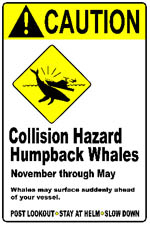NOAA Charges Vessel For Repeat Violations Of Whale Protection Rules
With Hawaii’s humpback whale season underway, officials are reminding boaters and other ocean users to use caution and follow whale protection rules. Federal regulations require people to stay at least 100 yards away from the wintering whales.

Image Courtesy NOAA
In the past two years, officials reported 12 cases involving violations, including approaches by swimmers, non-motorized watercraft, and motorized watercraft. In a recent case, officials with the NOAA’s Hawaiian Islands Humpback Whale National Marine Sanctuary say a commercial whale watch vessel was charged with violating the approach regulation on five separate occasions.
The case was settled in court on Maui when the owner and operator agreed to pay a civil penalty of $30,000. Humpback whale approach zone violations should be reported to NOAA’s Office of Law Enforcement at 1-800-853-1964. Additional guidelines and safety tips, can be found at http://hawaiihumpbackwhale.noaa.gov/explore/safe_boating.html
In addition to the water regulations, aircraft are required to stay 1,000 feet away when passing near whales. The “approach†regulations apply to all ocean users – power boaters, sailors, jet skiers, kayakers, paddlers, windsurfers, swimmers, divers – throughout the Hawaiian Islands.
“Everyone must be particularly cautious during whale season,†said Naomi McIntosh, superintendent, Humpback Whale National Marine Sanctuary. “If a humpback whale is sighted, you’re advised to stay well outside the 100-yard approach area. Keeping your speed down is also very important in helping us protect these animals.â€
Humpback whale season in Hawai‘i runs from November through May. As many as 10,000 humpback whales come to Hawaii during these months.
The Hawaiian Islands Humpback Whale National Marine Sanctuary was created by Congress in 1992 to protect humpback whales and their habitat in Hawai`i. The sanctuary, which lies within the shallow (less than 600 feet), warm waters surrounding the main Hawaiian Islands, constitutes one of the world’s most important humpback whale habitats.
(Posted by Wendy Osher; Supporting information provided by the NOAA Hawaiian Islands Humpback Whale National Marine Sanctuary)









